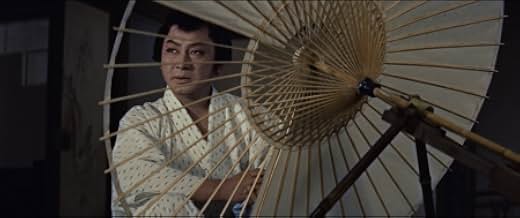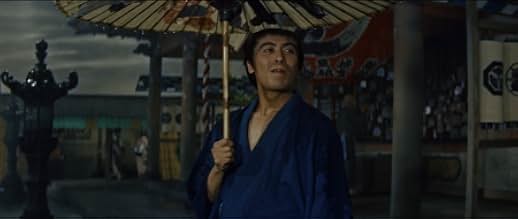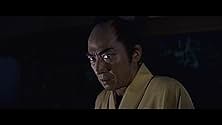Tôkaidô Yotsuya kaidan
- 1959
- 1 Std. 16 Min.
IMDb-BEWERTUNG
7,0/10
1917
IHRE BEWERTUNG
Füge eine Handlung in deiner Sprache hinzuThe ghost of a samurai's wife takes revenge on her husband.The ghost of a samurai's wife takes revenge on her husband.The ghost of a samurai's wife takes revenge on her husband.
Katsuko Wakasugi
- Iwa
- (as Kazuko Wakasugi)
Haruhiko Nakagawa
- Yomoshichi Satô
- (as Ryûzaburô Nakamura)
Handlung
WUSSTEST DU SCHON:
- VerbindungenFeatured in Building the Inferno: Nobuo Nakagawa and the Making of 'Jigoku' (2006)
Ausgewählte Rezension
Funny how things change. In 1949 Shintoho was producing prestige films like Akira Kurosawa's STRAY DOG. Ten years later they were producing scores of everything from lurid melodramas to nationalist war movies to cheap gangster flicks to kaidan period horror movies like this. Two years later, in 1961, they declared bankruptcy and closed shop, the first semi-big studio in postwar Japan to do so. Nobuo Nakagawa, along with Teruo Ishii who graduated from the film noir of the Chitai series into full blown sleaze and torture 10 years later, was one of those prolific studio filmmakers responsible for many of their kaidan pictures. His biggest call to fame is JIGOKU from the following year but this is an ample showcase of both the good and the bad of Shintoho film-making.
Based on the classic story by Nanboku Tsuruya about a conniving lowly samurai who is haunted by the ghost of the wife he murdered, a lot of the drama is hackneyed, the characters simple caricatures of good and evil, innocent and scheming, the dialogues delivered on-the-nose. Iemon, the murderous samurai, is played and depicted as the worst villain possible. No grey areas here, nothing morally ambiguous, the movie is melodrama played to the back of the house. And yet, the first appearance of the ghost sent chills down my spine. Ringu and Ju On didn't invent the pale-faced ghost that creeps along the edge of the frame. It was there 50 years ago and in Kabuki theater before that.
With the eye of a stylist, Nakagawa orchestrates a vision of hell on earth, ghosts rising from the ground or peering down from the ceiling, and it's all very stagey and theatrical probably to appeal to an audience already familiar with the story from Kabuki theater and as much creepy/atmospheric as it is graphic, certainly more graphic than American horror would dare to be for the next 10 years (we have blood gushing from wounds, facial deformities, and even an amputated limb), and while the whole is never as good as the parts, those parts should appeal to the horror fan who likes his lighting bright red and torquoise and his ghosts slow-moving and disfigured.
Based on the classic story by Nanboku Tsuruya about a conniving lowly samurai who is haunted by the ghost of the wife he murdered, a lot of the drama is hackneyed, the characters simple caricatures of good and evil, innocent and scheming, the dialogues delivered on-the-nose. Iemon, the murderous samurai, is played and depicted as the worst villain possible. No grey areas here, nothing morally ambiguous, the movie is melodrama played to the back of the house. And yet, the first appearance of the ghost sent chills down my spine. Ringu and Ju On didn't invent the pale-faced ghost that creeps along the edge of the frame. It was there 50 years ago and in Kabuki theater before that.
With the eye of a stylist, Nakagawa orchestrates a vision of hell on earth, ghosts rising from the ground or peering down from the ceiling, and it's all very stagey and theatrical probably to appeal to an audience already familiar with the story from Kabuki theater and as much creepy/atmospheric as it is graphic, certainly more graphic than American horror would dare to be for the next 10 years (we have blood gushing from wounds, facial deformities, and even an amputated limb), and while the whole is never as good as the parts, those parts should appeal to the horror fan who likes his lighting bright red and torquoise and his ghosts slow-moving and disfigured.
- chaos-rampant
- 13. Okt. 2009
- Permalink
Top-Auswahl
Melde dich zum Bewerten an und greife auf die Watchlist für personalisierte Empfehlungen zu.
- How long is The Ghost of Yotsuya?Powered by Alexa
Details
- Laufzeit1 Stunde 16 Minuten
- Seitenverhältnis
- 2.35 : 1
Zu dieser Seite beitragen
Bearbeitung vorschlagen oder fehlenden Inhalt hinzufügen

Oberste Lücke
By what name was Tôkaidô Yotsuya kaidan (1959) officially released in India in English?
Antwort

















